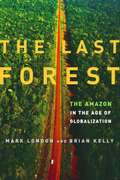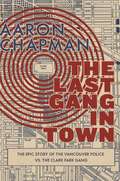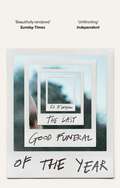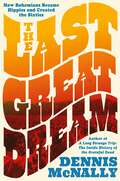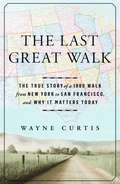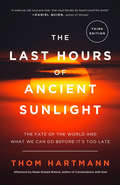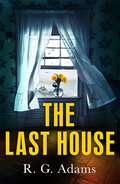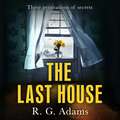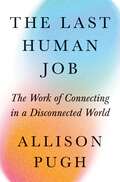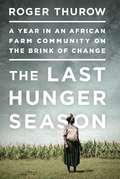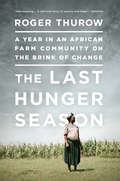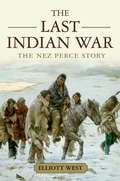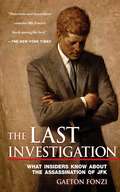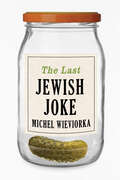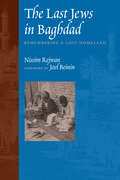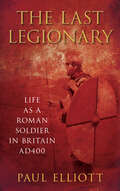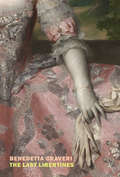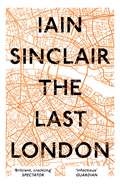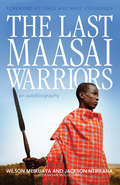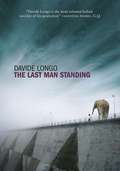- Table View
- List View
The Last Fine Time
by Verlyn KlinkenborgBy turns, an elegy, a celebration, and a social history, The Last Fine Time is a tour de force of lyrical style. Verlyn Klinkenborg chronicles the life of a family-owned restaurant in Buffalo, New York, from its days as a prewar Polish tavern to its reincarnation as George & Eddie's, a swank nightspot serving highballs and french-fried shrimp to a generation of optimistic and prosperous Americans. In the inevitable dimming of the neon sign outside the restaurant, we see both the passing of an old-world way of life and the end to the postwar exuberance that was Eddie Wenzek's "last fine time." Book jacket.
The Last Forest: The Amazon in the Age of Globalization
by Mark London Brian KellyWith a landmass larger than the continental U. S. west of the Mississippi and the richest diversity of plant and animal species on earth, the Amazon has always struck its explorers and would-be exploiters as infinite and largely impenetrable. For decades, anthropologists assumed that permanent human habitation was impossible–-but they were wrong. Recently, proof of centuries-old Amazonian civilizations has been unearthed, shifting perceptions of the inhospitability of the rain forest and providing a precedent for human occupation. Today, as developers and environmentalists clash over the region’s future, the seemingly endless forest is fast disappearing in fires, rampant mineral extraction, rogue logging operations, and encroaching urban sprawl. Through a series of startling human encounters–interviews with government ministers and environmental crusaders, millionaire ranchers and disenfranchised slum dwellers–Mark London and Brian Kelly, longtime explorers and trailblazing chroniclers of the Amazon basin, trace the region’s transformation. Logging thousands of miles, London and Kelly take readers from the mushrooming shopping malls of Manaus to the pristine rain forest that still seems beyond the reach of civilization, from the ghostly ruins of abandoned factories and failed plantations to the thriving agribusinesses that one day may feed the entire world and change this landscape forever. Again and again, they collide with the same fundamental question: Is it too late to strike a balance in the Amazon between economic sustenance for the twenty-one million Brazilians who live there and protection for the world’s last great forest? London and Brian Kelly have fashioned a complex, vibrant portrait of a region on the edge of crisis. At once a seductive journey and a searing account of political, environmental, and social tumult, The Last Forest is a masterpiece of contemporary reporting.
The Last Gang in Town
by Aaron ChapmanDecades before organized crime syndicates brought sensational drug wars to Vancouver, street gangs held sway over its unruly east side. None was considered tougher or more feared than the Clark Park gang, a wild, two-fisted crew of characters from Vancouver's post-1960s counterculture. In 1972, after a number of headline-making riots and clashes with police―including an infamous altercation outside a Rolling Stones concert―the Clark Parkers became the target of a secret undercover police squad. Their hostile interactions culminated in a notorious police shooting, resulting in the death of a Clark Park gang member. Combining meticulous research with a keen flair for storytelling, The Last Gang in Town features previously unpublished photos and police documents, as well as testimonials by surviving gang members and police officers who speak for the first time on the subject. The book is a compelling portrait of early-1970s Vancouver and an intriguing and sensational history that puts the spotlight on the after-dark underbelly of the city's not-so-distant criminal past.
The Last Good Funeral of the Year: A Memoir
by Ed O'LoughlinSoon, the lockdown would start. People would die alone, without any proper ceremony. Charlotte's death would be washed away, the first drop in a downpour. Nobody knew it then but hers would be the last good funeral of the year.It was February 2020, when Ed O'Loughlin heard that Charlotte, a woman he'd known had died, young and before her time. He realised that he was being led to reappraise his life, his family and his career as a foreign correspondent and acclaimed novelist in a new, colder light. He was suddenly faced with facts that he had been ignoring, that he was getting old, that he wasn't what he used to be, that his imagination, always over-active, had at some point reversed its direction, switching production from dreams to regrets. He saw he was mourning his former self, not Charlotte. The search for meaning becomes the driving theme of O'Loughlin's year of confinement. He remembers his brother Simon, a suicide at thirty; the journalists and photographers with whom he covered wars in Africa, the Middle East, the Balkans, wars that are hard to explain and never really stopped; his habit of shedding baggage, an excuse for hurrying past and not dwelling on things.Moving, funny, and searingly honest, The Last Good Funeral of the Year takes the reader on a circular journey from present to past and back to the present: 'Could any true story end any other way?'
The Last Good Funeral of the Year: A Memoir
by Ed O'LoughlinSoon, the lockdown would start. People would die alone, without any proper ceremony. Charlotte's death would be washed away, the first drop in a downpour. Nobody knew it then but hers would be the last good funeral of the year.It was February 2020, when Ed O'Loughlin heard that Charlotte, a woman he'd known had died, young and before her time. He realised that he was being led to reappraise his life, his family and his career as a foreign correspondent and acclaimed novelist in a new, colder light. He was suddenly faced with facts that he had been ignoring, that he was getting old, that he wasn't what he used to be, that his imagination, always over-active, had at some point reversed its direction, switching production from dreams to regrets. He saw he was mourning his former self, not Charlotte. The search for meaning becomes the driving theme of O'Loughlin's year of confinement. He remembers his brother Simon, a suicide at thirty; the journalists and photographers with whom he covered wars in Africa, the Middle East, the Balkans, wars that are hard to explain and never really stopped; his habit of shedding baggage, an excuse for hurrying past and not dwelling on things.Moving, funny, and searingly honest, The Last Good Funeral of the Year takes the reader on a circular journey from present to past and back to the present: 'Could any true story end any other way?'(P)2022 Quercus Editions Limited
The Last Great Dream: How Bohemians Became Hippies and Created the Sixties
by Dennis McNally"McNally masterfully combines many disparate lineages of political, social, art, and pop history into one singular, sweeping portrait. The result is a stunning vision of a broad and powerful idealism that gripped the world for more than two decades."--Publishers Weekly (starred review) From the New York Times bestselling author of A Long Strange Trip and the publicist of the Grateful Dead, a riveting social history of everything that led up to the 1960s counterculture movement. Few cities represent the countercultural movement of the 1960s more than San Francisco. By that decade, the Haight-Ashbury neighborhood was home to self-branded &“freaks&” (dubbed &“hippies&” by the media) who created the world&’s first psychedelic neighborhood—an alchemical chamber for social transformation. They rejected a large part of the traditional American identity, passing over American exceptionalism, consumerism, misogyny, and militarism in favor of creativity, mind-body connection, peace, and love of all things.The Last Great Dream is a history of everything that led to the 1960s counterculture, when long-simmering resistance to American mainstream values birthed the hippie. It begins with the San Francisco Poetry Renaissance, peaks with the Human Be-in in Golden Gate Park, and ends with the Monterey Pop Festival that introduced Jimi Hendrix and Janis Joplin to the world. It tells of several micro-histories, including beat poetry, visual arts, underground publishing, electronic/contemporary compositional music, experimental theater, psychedelics, and more. Fascinating and definitive, The Last Great Dream is the ultimate guide to a generation-defining countercultural movement—an Underground 101 course for newcomers and aficionados alike.
The Last Great Walk: The True Story of a 1909 Walk from New York to San Francisco, and Why it Matters Today
by Wayne CurtisIn 1909, Edward Payson Weston walked from New York to San Francisco, covering around 40 miles a day and greeted by wildly cheering audiences in every city. The New York Times called it the "first bona-fide walk ... across the American continent," and eagerly chronicled a journey in which Weston was beset by fatigue, mosquitos, vicious headwinds, and brutal heat. He was 70 years old.In The Last Great Walk, journalist Wayne Curtis uses the framework of Weston's fascinating and surprising story, and investigates exactly what we lost when we turned away from foot travel, and what we could potentially regain with America's new embrace of pedestrianism. From how our brains and legs evolved to accommodate our ancient traveling needs to the way that American cities have been designed to cater to cars and discourage pedestrians, Curtis guides readers through an engaging, intelligent exploration of how something as simple as the way we get from one place to another continues to shape our health, our environment, and even our national identity.Not walking, he argues, may be one of the most radical things humans have ever done.
The Last Great War
by Adrian GregoryWhat was it that the British people believed they were fighting for in 1914–18? This compelling history of the British home front during the First World War offers an entirely new account of how British society understood and endured the war. Drawing on official archives, memoirs, diaries and letters, Adrian Gregory sheds new light on the public reaction to the war, examining the role of propaganda and rumour in fostering patriotism and hatred of the enemy. He shows the importance of the ethic of volunteerism and the rhetoric of sacrifice in debates over where the burdens of war should fall as well as the influence of religious ideas on wartime culture. As the war drew to a climax and tensions about the distribution of sacrifices threatened to tear society apart, he shows how victory and the processes of commemoration helped create a fiction of a society united in grief.
The Last Gun
by Tom DiazNewtown, Connecticut. Aurora, Colorado. Both have entered our collective memory as sites of unimaginable heartbreak and mass slaughter perpetrated by lone gunmen. Meanwhile, cities such as Chicago and Washington, D.C., are dealing with the painful, everyday reality of record rates of gun-related deaths. By any account, gun violence in the United States has reached epidemic proportions.A widely respected activist and policy analyst--as well as a former gun enthusiast and an ex-member of the National Rifle Association--Tom Diaz presents a chilling, up-to-date survey of the changed landscape of gun manufacturing and marketing. The Last Gun explores how the gun industry and the nature of gun violence have changed, including the disturbing rise in military-grade gun models. But Diaz also argues that the once formidable gun lobby has become a "paper tiger," marshaling a range of evidence and case studies to make the case that now is the time for a renewed political effort to attack gun violence at its source--the guns themselves.In the aftermath of Newtown, a challenging national conversation lies ahead. The Last Gun is an indispensable guide to this debate, and essential reading for anyone who wants to understand how we can finally rid America's streets, schools, and homes of gun violence and prevent future Newtowns.
The Last Hours of Ancient Sunlight: The Fate of the World and What We Can Do Before It's Too Late
by Thom HartmannWhile everything appears to be collapsing around us -- ecodamage, genetic engineering, virulent diseases, the end of cheap oil, water shortages, global famine, wars -- we can still do something about it and create a world that will work for us and for our children's children. The inspiration for Leonardo DiCaprio's web movie Global Warning, The Last Hours of Ancient Sunlight details what is happening to our planet, the reasons for our culture's blind behavior, and how we can fix the problem. Thom Hartmann's comprehensive book, originally published in 1998, has become one of the fundamental handbooks of the environmental activist movement. Now, with fresh, updated material and a focus on political activism and its effect on corporate behavior, The Last Hours of Ancient Sunlight helps us understand--and heal--our relationship to the world, to each other, and to our natural resources.
The Last House: an intense psychological thriller of locked doors and family secrets
by R. G. Adams'I'm completely hooked. Adams is a skilled and engaging writer' Alex MarwoodTHREE GENERATIONS OF SECRETSSocial worker Kit Goddard is convinced that Sandbeach Child Services have let an injured seventeen-year-old boy down, just like they'd done to her brother ten years earlier. Since the referral came in, it had been passed between departments, her own manager Georgia and colleague Tim brushing it off as a low risk, low priority case. But Kit can't shake the feeling that something isn't quite right. Scanning the referral, she notices that the house seventeen-year-old Dylan Meredith lives in with his 'weird' mother had been described as decrepit. The anonymous caller said he was injured, frightened and afraid to tell the truth. As Kit begins to look deeper into the history of the family, she learns that Dylan's grandmother had been an inpatient at Penlan psychiatric hospital and had died there in 2012. But as her colleague Tim had stressed, this was not a case for psychiatric services. In a bid to trace the anonymous caller for more information, Kit sets off to the small coastal town of Rock. Only to be confronted with the sense of strangeness that surrounds the Meredith family and the rumours that have troubled this small community for years. An intense psychological thriller, The Last House shows that the darkest secrets are hidden within the walls. But no matter how big you build them the truth will always find a way of breaking out.
The Last House: an intense psychological thriller of locked doors and family secrets
by R. G. AdamsSocial worker Kit Goddard is convinced that Sandbeach Child Services have let an injured seventeen-year-old boy down, just like they'd done to her brother ten years earlier. Since the referral came in, it had been passed between departments, her own manager Georgia and colleague Tim brushing it off as a low risk, low priority case. But Kit can't shake the feeling that something isn't quite right.Scanning the referral, she notices that the house seventeen-year-old Dylan Meredith lives in with his 'weird' mother had been described as decrepit. The anonymous caller said he was injured, frightened and afraid to tell the truth. As Kit begins to look deeper into the history of the family, she learns that Dylan's grandmother had been an inpatient at Penlan psychiatric hospital and had died there in 2012. But as her colleague Tim had stressed, this was not a case for psychiatric services. In a bid to trace the anonymous caller for more information, Kit sets off to the small coastal town of Rock. Only to be confronted with the sense of strangeness that surrounds the Meredith family and the rumours that have troubled this small community for years. An intense psychological thriller, The Last House shows that the darkest secrets are hidden within the walls. But no matter how big you build them the truth will always find a way of breaking out. (P) 2022 Quercus Editions Limited
The Last Human Job: The Work of Connecting in a Disconnected World
by Allison J. PughA timely and urgent argument for preserving the work that connects us in the age of automationWith the rapid development of artificial intelligence and labor-saving technologies like self-checkouts and automated factories, the future of work has never been more uncertain, and even jobs requiring high levels of human interaction are no longer safe. The Last Human Job explores the human connections that underlie our work, arguing that what people do for each other in these settings is valuable and worth preserving.Drawing on in-depth interviews and observations with people in a broad range of professions—from physicians, teachers, and coaches to chaplains, therapists, caregivers, and hairdressers—Allison Pugh develops the concept of &“connective labor,&” a kind of work that relies on empathy, the spontaneity of human contact, and a mutual recognition of each other&’s humanity. The threats to connective labor are not only those posed by advances in AI or apps; Pugh demonstrates how profit-driven campaigns imposing industrial logic shrink the time for workers to connect, enforce new priorities of data and metrics, and introduce standardized practices that hinder our ability to truly see each other. She concludes with profiles of organizations where connective labor thrives, offering practical steps for building a social architecture that works.Vividly illustrating how connective labor enriches the lives of individuals and binds our communities together, The Last Human Job is a compelling argument for us to recognize, value, and protect humane work in an increasingly automated and disconnected world.
The Last Hunger Season
by Roger ThurowAt 4:00 am, Leonida Wanyama lit a lantern in her house made of sticks and mud. She was up long before the sun to begin her farm work, as usual. But this would be no ordinary day, this second Friday of the new year. This was the day Leonida and a group of smallholder farmers in western Kenya would begin their exodus, as she said, “from misery to Canaan,” the land of milk and honey. Africa’s smallholder farmers, most of whom are women, know misery. They toil in a time warp, living and working essentially as their forebears did a century ago. With tired seeds, meager soil nutrition, primitive storage facilities, wretched roads, and no capital or credit, they harvest less than one-quarter the yields of Western farmers. The romantic ideal of African farmers––rural villagers in touch with nature, tending bucolic fields––is in reality a horror scene of malnourished children, backbreaking manual work, and profound hopelessness. Growing food is their driving preoccupation, and still they don’t have enough to feed their families throughout the year. Thewanjala––the annual hunger season that can stretch from one month to as many as eight or nine––abides. But in January 2011, Leonida and her neighbors came together and took the enormous risk of trying to change their lives. Award-winning author and world hunger activist Roger Thurow spent a year with four of them––Leonida Wanyama, Rasoa Wasike, Francis Mamati, and Zipporah Biketi––to intimately chronicle their efforts. InThe Last Hunger Season,he illuminates the profound challenges these farmers and their families face, and follows them through the seasons to see whether, with a little bit of help from a new social enterprise organization called One Acre Fund, they might transcend lives of dire poverty and hunger. The daily dramas of the farmers’ lives unfold against the backdrop of a looming global challenge: to feed a growing population, world food production must nearly double by 2050. If these farmers succeed, so might we all.
The Last Hunger Season: A Year in an African Farm Community on the Brink of Change
by Roger ThurowAt 4:00 am, Leonida Wanyama lit a lantern in her house made of sticks and mud. She was up long before the sun to begin her farm work, as usual. But this would be no ordinary day, this second Friday of the new year. This was the day Leonida and a group of smallholder farmers in western Kenya would begin their exodus, as she said, "from misery to Canaan," the land of milk and honey.Africa's smallholder farmers, most of whom are women, know misery. They toil in a time warp, living and working essentially as their forebears did a century ago. With tired seeds, meager soil nutrition, primitive storage facilities, wretched roads, and no capital or credit, they harvest less than one-quarter the yields of Western farmers. The romantic ideal of African farmers--rural villagers in touch with nature, tending bucolic fields--is in reality a horror scene of malnourished children, backbreaking manual work, and profound hopelessness. Growing food is their driving preoccupation, and still they don't have enough to feed their families throughout the year. The wanjala--the annual hunger season that can stretch from one month to as many as eight or nine--abides.But in January 2011, Leonida and her neighbors came together and took the enormous risk of trying to change their lives. Award-winning author and world hunger activist Roger Thurow spent a year with four of them--Leonida Wanyama, Rasoa Wasike, Francis Mamati, and Zipporah Biketi--to intimately chronicle their efforts. In The Last Hunger Season, he illuminates the profound challenges these farmers and their families face, and follows them through the seasons to see whether, with a little bit of help from a new social enterprise organization called One Acre Fund, they might transcend lives of dire poverty and hunger.The daily dramas of the farmers' lives unfold against the backdrop of a looming global challenge: to feed a growing population, world food production must nearly double by 2050. If these farmers succeed, so might we all.
The Last Indian War: The Nez Perce Story (Pivotal Moments In American History)
by Elliott WestThis newest volume in Oxford's acclaimed Pivotal Moments series offers an unforgettable portrait of the Nez Perce War of 1877, the last great Indian conflict in American history. It was, as Elliott West shows, a tale of courage and ingenuity, of desperate struggle and shattered hope, of short-sighted government action and a doomed flight to freedom. <p><p> To tell the story, West begins with the early history of the Nez Perce and their years of friendly relations with white settlers. In an initial treaty, the Nez Perce were promised a large part of their ancestral homeland, but the discovery of gold led to a stampede of settlement within the Nez Perce land. Numerous injustices at the hands of the US government combined with the settlers' invasion to provoke this most accomodating of tribes to war. West offers a riveting account of what came next: the harrowing flight of 800 Nez Perce, including many women, children and elderly, across 1500 miles of mountainous and difficult terrain. He gives a full reckoning of the campaigns and battles--and the unexpected turns, brilliant stratagems, and grand heroism that occurred along the way. And he brings to life the complex characters from both sides of the conflict, including cavalrymen, officers, politicians, and--at the center of it all--the Nez Perce themselves (the Nimiipuu, "true people"). The book sheds light on the war's legacy, including the near sainthood that was bestowed upon Chief Joseph, whose speech of surrender, "I will fight no more forever," became as celebrated as the Gettysburg Address. <p> Based on a rich cache of historical documents, from government and military records to contemporary interviews and newspaper reports, The Last Indian War offers a searing portrait of a moment when the American identity--who was and who was not a citizen--was being forged.
The Last Investigation: A Former Federal Investigator Reveals the Man behind the Conspiracy to Kill JFK
by Marie Fonzi Gaeton FonziGaeton Fonzi's masterful retelling of his work investigating the Kennedy assassination for two congressional committees is required reading for students of the assassination and the subsequent failure of the government to solve the crime. <P><P>His book is a compelling postmortem on the House Select Committee on Assassinations, as well as a riveting account of Fonzi's pursuit of leads indicating involvement in the assassination by officers of the Central Intelligence Agency.First released in 1993, The Last Investigation was a landmark book upon its release. More than merely an indictment of the Committee's work, Fonzi tells the story of the important leads he developed as an investigator, which sent him into the milieu of Kennedy-haters among anti-Castro exiles and CIA officers. In this highly readable book, the author follows the trail to formerly obscure CIA officers such as David Atlee Phillips and David Morales. New records declassified under the JFK Records Act have only added to the dark questions raised here.
The Last Jewish Gangster: The Early Years
by David Larson“A captivating and different kind of story” about the life of Bugsy Siegel’s godson, from the author “who captured his voice” (Nick Pileggi, author/screenwriter of Goodfellas and Casino).In 1944 Brooklyn, newborn Michael J. Hardy is rejected by his mother so she can run with gangster Bugsy Siegel, Hardy’s godfather. Shirley Rook rose to the top of the criminal ranks. As the Queen of New York City crime, she laundered Mob money, ran the city’s largest bookmaking operation, and handed payouts to dirty cops, politicians, and judges.To win his mother’s love and respect, Hardy became a fearless gangster. Throughout his career as a mercenary, he robbed banks and drug dealers alike, ran a kidnapping ring, and even became a hired gun. At his lowest, he ended up doing time for his mother’s counterfeiting operation in Mexico’s most dangerous prison.Hardy’s criminal code of conduct combines elements of tough Ukrainian Jew and warm Southern Baptist, whether dealing with family and friends or fellow inmates during a combined twenty-six years spent in prisons and jails. He maintained this characteristic gregarious strength throughout his astonishing life in which Hardy was shot eleven times, committed fourteen hits for the Mob, twice wore wires for Rudy Giuliani to nab dirty cops, wrote a letter to JFK to get out of military prison, choked the Hillside Strangler, shared prison time with notorious criminals, and even spent ten years in Hollywood, cast in non-speaking roles in B-movies.“A fascinating character study of an unapologetic criminal. David S. Larson masterfully weaves this tale in Michael Hardy’s own words, resulting in a powerful, inside story of a gangster’s life.” —Cathy Scott, Los Angeles Times-bestselling author
The Last Jewish Joke
by Michel WieviorkaThe golden age of Jewish humour flourished in the second half of the twentieth century, enjoyed by Jews and non-Jews alike, but its twilight years are now in sight. Telling jokes has the potential to reaffirm community once religion, political loyalties and victimhood are stripped away: from the 1960s on, a unique cultural dynamism bound up in these jokes reminded Jews around the world of what it means to be Jewish. Often, jokes pit one group against another, but Jewish jokes opted for self-deprecation instead, and in this case, laughing at the group reinforced it. They enabled Jews to live in harmony with others in full conscience of their differences and they safeguarded a desire for survival at the heart of Jewish identity. Moreover, absurd, larger-than-life characters such as Rabbi Jacob generated tolerance, empathy and tenderness among non-Jews after the horror and guilt of the Shoah. From the early 2000s, however, the space that allowed Jewish jokes to flourish began to shrink, due to a decline in the understanding of the Shoah, a less positive image of Israel and a waning of the importance of Jewish culture in American intellectual and cultural life. This playful and personal book by Michel Wieviorka includes Jewish jokes but also laments the disappearance of the Jewish joke and eulogises its ability to allow the thriving of community alongside difference. It is an original and wide-ranging analysis of the evolution of the diaspora and its relationship with the State of Israel, its history and dramas as well as its cultural creativity.
The Last Jews in Baghdad: Remembering a Lost Homeland
by Nissim Rejwan foreword by Joel BeininOnce upon a time, Baghdad was home to a flourishing Jewish community. More than a third of the city's people were Jews, and Jewish customs and holidays helped set the pattern of Baghdad's cultural and commercial life. On the city's streets and in the bazaars, Jews, Muslims, and Christians-all native-born Iraqis-intermingled, speaking virtually the same colloquial Arabic and sharing a common sense of national identity. And then, almost overnight it seemed, the state of Israel was born, and lines were drawn between Jews and Arabs. Over the next couple of years, nearly the entire Jewish population of Baghdad fled their Iraqi homeland, never to return. In this beautifully written memoir, Nissim Rejwan recalls the lost Jewish community of Baghdad, in which he was a child and young man from the 1920s through 1951. He paints a minutely detailed picture of growing up in a barely middle-class family, dealing with a motley assortment of neighbors and landlords, struggling through the local schools, and finally discovering the pleasures of self-education and sexual awakening. Rejwan intertwines his personal story with the story of the cultural renaissance that was flowering in Baghdad during the years of his young manhood, describing how his work as a bookshop manager and a staff writer for the Iraq Times brought him friendships with many of the country's leading intellectual and literary figures. He rounds off his story by remembering how the political and cultural upheavals that accompanied the founding of Israel, as well as broad hints sent back by the first arrivals in the new state, left him with a deep ambivalence as he bid a last farewell to a homeland that had become hostile to its native Jews.
The Last Legionary: Life as a Roman Soldier in Britain AD400
by Paul ElliottIn AD 400 Roman rule in Britain was collapsing as the thinly stretched empire was beseiged on all sides. In 'The Last Legionary', Paul Elliot explores all aspects of Late Roman military life, from recruitment to weaponry, marriage to wages, warfare to religion. It explores the world of the Roman soldier through the eyes of one man, posted to a British garrison at the edge of the empire, and follows the soldier's life through training and battle, marriage and business dealings, finally following him south as he leaves Britain for good in defence of Rome. When the legionary finally escapes the worst posting in the Roman Empire, it is only to join what effectively beame a death march over the Alps, without food or shelter. To know what it was like to face the chanted battle cry, the charge and slashing axes of the Goths, and to understand why the order 'march out!' was so terrifying, read Paul Elliott's mesmerising, meticulously accurate account.
The Last Libertines
by Benedetta CraveriAn enthralling work of history about the Libertine generation that came up during—and was eventually destroyed by—the French Revolution.The Last Libertines, as Benedetta Craveri writes in her preface to the book, is the story of a group of &“seven aristocrats whose youth coincided with the French monarchy&’s final moment of grace—a moment when it seemed to the nation&’s elite that a style of life based on privilege and the spirit of caste might acknowledge the widespread demand for change, and in doing so reconcile itself with Enlightenment ideals of justice, tolerance, and citizenship.&” Here we meet seven emblematic characters, whom Craveri has singled out not only for &“the romantic character of their exploits and amours—but also by the keenness with which they experienced this crisis in the civilization of the ancien régime, of which they themselves were the emblem.&” Displaying the aristocratic virtues of &“dignity, courage, refinement of manners, culture, [and] wit,&” the Duc de Lauzun, the Vicomte de Ségur, the Duc de Brissac, the Comte de Narbonne, the Chevalier de Boufflers, the Comte de Ségur, and the Comte de Vaudreuil were at the same time &“irreducible individualists&” and true &“sons of the Enlightenment,&” all of them ambitious to play their part in bringing around the great changes that were in the air. When the French Revolution came, however, they found themselves condemned to poverty, exile, and in some cases execution. Telling the parallel lives of these seven dazzling but little-remembered historical figures, Craveri brings the past to life, powerfully dramatizing a turbulent time that was at once the last act of a now-vanished world and the first act of our own.
The Last London: True Fictions from an Unreal City
by Iain SinclairA New Statesman Book of the Year London. A city apart. Inimitable. Or so it once seemed. Spiralling from the outer limits of the Overground to the pinnacle of the Shard, Iain Sinclair encounters a metropolis stretched beyond recognition. The vestiges of secret tunnels, the ghosts of saints and lost poets lie buried by developments, the cycling revolution and Brexit. An electrifying final odyssey, The Last London is an unforgettable vision of the Big Smoke before it disappears into the air of memory.
The Last Maasai Warriors
by Susan Mcclelland Jackson Ntirkana Wilson MeikuayaHow two young Maasai tribesmen became warriors, scholars, and leaders in their community and to the world.They are living testament to a vanishing way of life on the African savannah. Wilson and Jackson are two brave warriors of the Maasai, an intensely proud culture built on countless generations steeped in the mystique of tradition, legend and prophecy. They represent the final generation to literally fight for their way of life, coming of age by proving their bravery in the slaying of a lion. They are the last of the great warriors.Yet, as the first generation to fully embrace the modern ways and teachings of Western civilization, the two warriors have adapted -- at times seamlessly, at times with unimaginable difficulty -- in order to help their people. They strive to preserve a disappearing culture, protecting the sanctity of their elders while paving the way for future generations.At this watershed moment in their history, the warriors carry the weight of their forbearers while embracing contemporary culture and technology. While their struggle to achieve this balance unfolds exquisitely in this story, their discoveries resonate well beyond the Maasai Mara.
The Last Man Standing: The chilling apocalyptic thriller that predicts Italy's collapse
by Davide LongoA chillingly plausible novel about the collapse of Italian society and one man's struggle to retain his humanity amid the horror"A bleak, lyrical tale that evokes Cormac McCarthy's The Road.... Gruesome, intense, and strange... a eurozone nightmare brought to life on the page."--James Lovegrove, Financial TimesIt is 2025, and Italy is on the brink of collapse. Borders are closed, banks withhold money, the postal service stalls. Armed gangs of drug-fuelled youths roam the countryside. Leonardo was a famous writer and professor before a sex scandal ended his marriage and career. Heading north in search of her new husband, his ex-wife leaves their daughter and her son in his care. If he is to take them to safety, he will need to find a quality he has never possessed: courage.

